Yes, I Know - But Will It Kill You?
Flirting with danger in the Land Down Under . . .
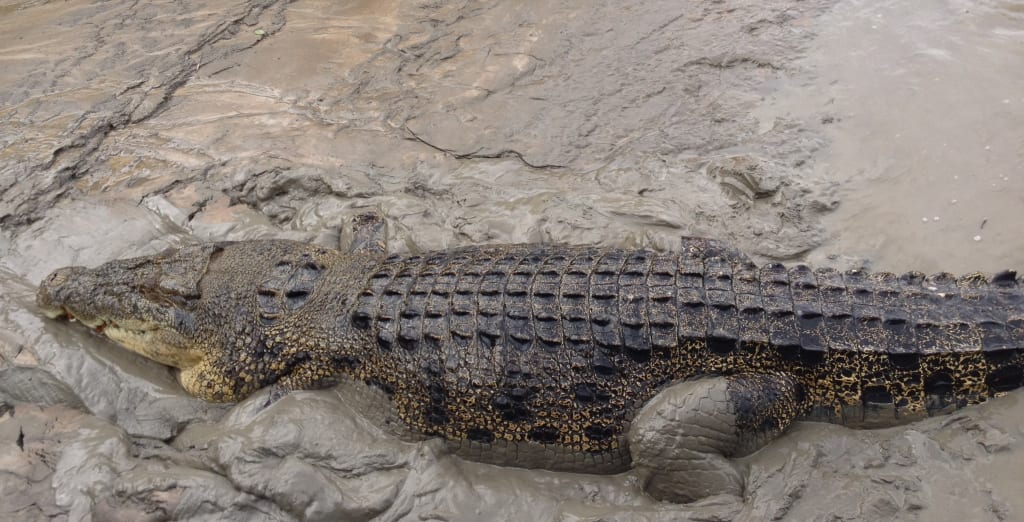
Australia is a land of rare and immense beauty – rugged most of the time, and unique all of it. It is also a land of unexpected treasures. At times one can look out from a moving train window or hop out of a car at a petrol station (and they are called petrol stations as opposed to gas stations or service stations) or take a walk along a beach or a hiking trail and see nothing in nature that looks the least little bit familiar to that to which we have become accustomed.

From a moderate distance (like from an airplane flying at 35 000 feet coming into Australian air space from Singapore), trees still look like trees and birds still look vaguely like birds – I mean they fly (some anyway) and all of the normal things that birds do. However, that’s where the similarities end – the trees each have their own individual character and on seeing them they immediately demand your attention. For example, I took my first photograph of an Australian eucalypt (Gum tree) on day one of our journey Down Under and, then my last of 4398 “tree” pictures, 58 days later – and that final shot was possibly of the same tree I took in the first picture (they all look so different from each other and even from previous images of the same tree) - all of this despite being residents in a forest where that character could easily be lost – lost, of course, if it weren’t for the fact that the trees themselves have branches that can’t decide which direction to grow and that have the same diameter as the trunk.
The birds, not to be outdone by the vegetation in Australia, seem to have heads that are too big for their bodies or else bodies that are too big for their heads and they sing tunes that non-Aussies have never heard before.

They are usually of a color-pattern unknown to most North Americans. Kookaburras, for instance which actually do sit in gum trees like the old song says, (but then what choice do they have as 9 out of ten trees are gum trees) appear to have no neck, and make the most jungle-like conglomeration of noises every now and then. Each time they laugh, it causes one to bolt instantly for a camera with audio capabilities so as to catch this unique presentation of vocal talents. My wife made significant efforts to catch these vocalizations and I believe she was eventually rewarded. I never did capture a live audio track but, I just so happened to have my camera handy one day when I was in the souvenir shop at the Sydney Westfield Tower. The shop had toy “Kooks” for sale. These toys danced around the floor while doing their famous and original cackle. So I videotaped that performance instead, and, well, . . . it’s almost like the real thing!
The landscape of Australia is either covered with lush, green, tropical rainforest, or it is part of a stratified rocky shoreline being battered my monstrous, roaring, foaming turquoise waves, or it is painted with a brilliantly pristine, white-sand beach.

Or, it is simply an endless red desert. And, I do believe the latter to usually be the case. This country is almost entirely an endless red desert. But even so, there is a beauty about that big red desert. It did take about two- and one-half hours to pass over it travelling in a Boeing jet at 77% of the speed of sound in a southeasterly direction across the continent, so we know it is big and, yes, it certainly is red.
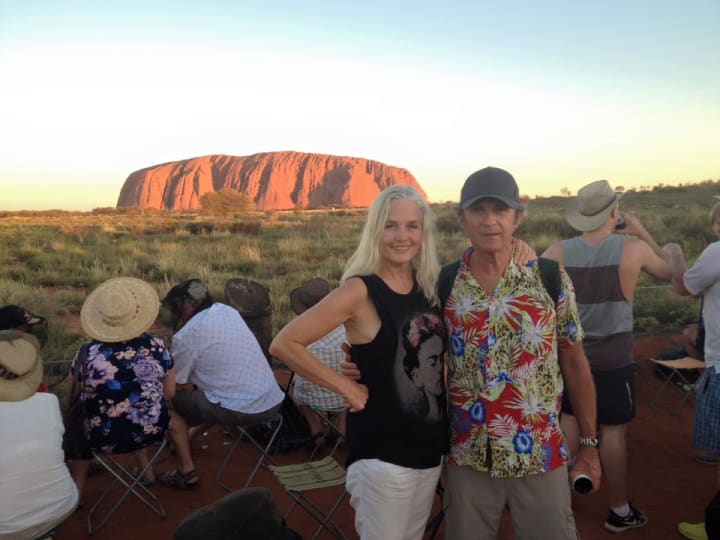
Culturally, Australia is truly Western. On one hand, it is sort of like being in America. Everything is big and extreme and dangerous and breath-taking and worthy of a least several dozen photos from several different angles at various exposures and shutter speeds. The sights you see and the stories you hear are just, well, er, . . . well you just can’t make that stuff up. Even the things that would seem sort of regular for us are made a little more extreme by the addition of a phrase or a lick of paint. For example, the Predictive Forest Fire Danger signs you see by the side of the road in National Parks in North America usually range from Low through Moderate to High and on to Extreme. In Australia, however, they have added one more category on the most dangerous end – that being CATASTROPHIC. But, rightly so, because I have been told by a former high school mate of mine that when a eucalypt tree burns, the large quantities of oil in its trunk, branches and leaves cause it to literally explode.
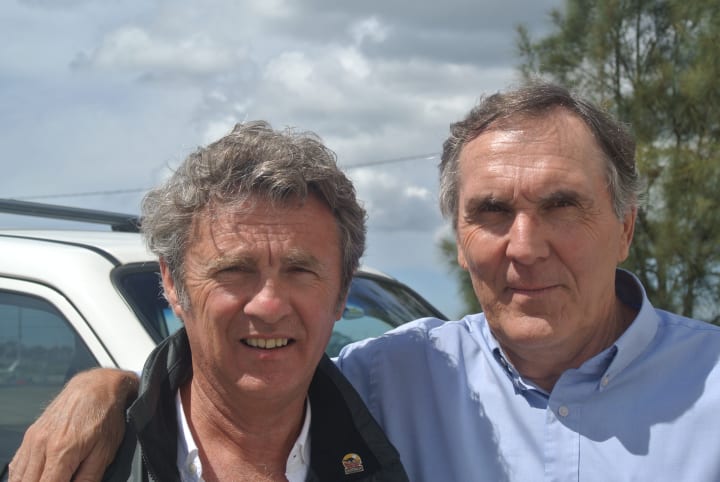
Flaming shrapnel flies off in every direction, igniting other eucalypts as a result. A big fire in Manly (a borough of Sydney) in the mid 90s stranded my friend in his yard for hours with no way out. The fire wiped out everything in the 5 acre plot with the exception of the house. His final analysis of the situation was that it was a bit annoying, but it did help him clean up the brush that he didn’t have time to tidy up previously.
The folks in Australia are bold and sometimes brash and most often sports-minded and always very competitive and, of course, they are proud to be Australian. Every guide and interpreter that we encountered on our trip sounded and acted as though they had graduated from the Steve Irwin School of “Let’s-Promote-Australia-in-the-Most-Hair-Raising-Manner-Possible”. “Crickey, that dead leaf on the ground right there is probably one of the brownest leaves you will ever come across. Be sure to stand well back when you are watching this one. Why within 15 seconds of its hitting the ground you are going to see no less than 25 Godzilla ants carry it off. There is no messing with any dead leaves in this area and especially when they are being rushed away by those very ambitious Godzilla ants.” After hearing a report like this regarding a dead leaf and a small group of insects, one might imagine that a guided interpretation of the sighting of, say, a 20-foot crocodile or a Blue Box Jellyfish would be through the roof but surprisingly it ends up not being a whole lot different. The tone and exuberance are the same whether it is the lunch menu being described or directions given to the nearest public toilet or whether one is hearing about a gang of Great Whites circling in a holding pattern around the tour boat.
And speaking of lunch, the everyday food in Australia is westernized in spades and intended to satisfy, if not completely satiate someone sticking to a strictly carnivorous diet. A hamburger meal, for instance, is almost entirely meat (measured by either mass or volume – you pick), with some fries on the side if you ask for them. Ordering a salad with a meal usually produces quizzical looks on the faces of servers and great consternation and confusion in the kitchen when the order is passed on to the cooks. The only food that makes you think you are somewhere else (like in the MIR Space Station or something) is Vegemite. Vegemite is used in Australia to punish small children who have misbehaved in inappropriate manners and to deter small pets from peeing on carpets and such. Vegemite is the reason why everything else in Australia tastes so good. The jury is still out on the chemical make-up of Vegemite, but it is my understanding that multi-gold-medal winning swimmer, Ian Thorpe, grew up on Vegemite, so I guess it can’t be all bad. Apparently, it doesn’t show up in the drug tests for banned substances in the Olympics either!
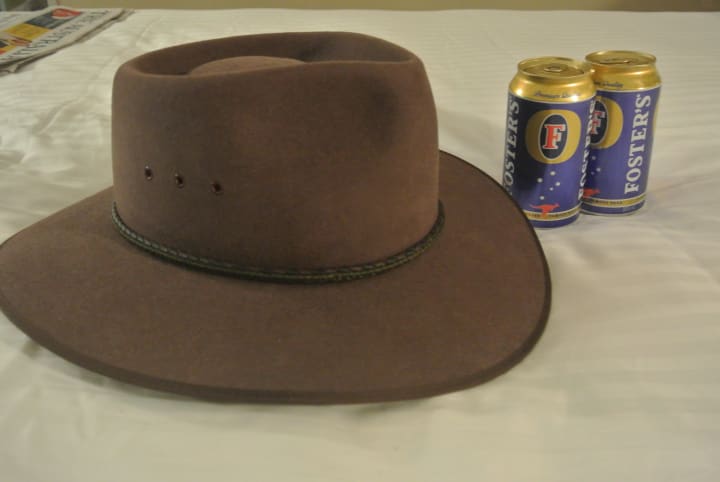
As American as Australia seems at first glance on the outside, it is still set within the matrix of the UK. Britain is still considered home to many Australians even though they have never lived there or even travelled there. Vehicles are driven on the left side of the road. Tea is taken at the appropriate time in the late afternoon and neighborhoods are sprinkled with pubs all of which have television monitors strategically placed within so that every patron in the establishment can watch the current live broadcast of the National Cricket League game being aired that day. As far as I could tell, cricket matches start early each morning and carry on throughout the entire day and then end sometime late in the late evening just nicely before the next match starts. Sometimes I wonder if they ever really end at all. Regardless, Australians do love their cricket and their British roots.
So Australia is beautiful and magnificent and strange and different and large (and it is unfathomably large) – one should never plan a vacation to this Island Continent without using a travel map any smaller than a school gymnasium – its size is unbelievably deceptive – 3 million square miles of the basically flattest land surface on the planet with a distance of coastline equal to the circumference of the earth at the equator – it is impossible to see the whole country in just 58 days. Five months maybe; five years more like it – it would be a far less daunting task to say “G’day mate!” to all 20 million Australian citizens in a reception line, in five months, than it would be to see everything the country has to offer in that same time period.

As much as Australia is all of these wonderfully marvelous and breath-taking sights and sounds it is also an extremely dangerous place for humans to live and visit. Steve Irwin was not kidding when he described almost any living thing from this country as “ . . . the most dangerous creature you’ll ever come across on the way back to your tent after a middle-of-the-night bathroom break.” My research, albeit recent and somewhat limited, has indicated that animal creatures (and even plants) in Australia are the most harmful and deadly in existence on the planet today, or ever for that matter. Australians themselves, should also be considered very dangerous for the descriptions and nonchalant warnings about these creatures they pass along to foreigners. Australians have had to live amongst these creatures on a daily and lifetime basis and in a country so filled with extreme weather and deadly oceans and jungles that, I believe they have become desensitized to the possibility of bites, stings, brushes and kicks that these organisms may provide for an unaware passer-by. They have shifted the continuum of danger ten giant steps to the right and developed a brand new vocabulary for describing just how defiling one of these phenomena can be, based on whether it kills you instantly, or after four excruciatingly painful hours in a hospital emergency ward or whether it simply dismembers or disfigures you for life. I use the term phenomena at this point rather than creature because if a living organism fails to snuff you out, then a rip tide or a cyclone or an unprepared-for walkabout in the bush or outback through a barren red desert during a 145◦F heat wave (that feels like sticking your head into an oven to check the Christmas turkey) on top of an extended four-year drought will certainly finish you off in a hurry. It is amazing the number of stories we heard while travelling in Australia, involving human encounters with nature and her vast numbers of exotic flora and fauna that ended with the phrase: “and they were never seen again!”
With these thoughts of inherent danger in mind, I have come up with my own personal top ten list of the most deadly and disfiguring phenomena a member of the human species can face while living or travelling in Australia. This list is based on discussions with so-called danger experts we bumped into along the way during our 58 days in the Land Down Under. Keep in mind that I have translated some of the unique criteria for danger that most Australians seem to possess in their informational repertoire. For instant something that kills you instantly in such a way that the process can be witnessed by at least 10 adults (one of which must be a medical professional) is rightly considered to be extremely dangerous, whereas a creature that simply bites off a limb or two before moving on to greener pastures, would only be classified as mildly annoying. To me, either one of these situations is describable as horrific. But, to an Australian, the dangerous to non-dangerous continuum of adjectives might look something like:
1. Extremely Catastrophic – an example of something exhibiting this degree of danger might be a meteorite the size of Mars smashing full-force and head-long into the earth, thus instantly obliterating all worldly life and inhabitants and reducing both worlds to cosmic dust.
2. Horrendous – example – a 500 gigaton nuclear fusion bomb falling anywhere on the planet earth, initiating a domino effect of earthquakes and tsunamis that would eventually kill all life on the planet.
And so on, down the continuum to descriptor #10 . . .
10. Irritating – example – losing one arm and a leg or both legs while snorkeling on the Great Barrier Reef, to a shark merely wishing to administer a “Test Bite”.
Anyway, to compose this list, I have shifted the danger continuum back to the left and I have also done some reclassification of terms. I will add explanations as necessary in the list.
And now, from the home box office in Cairns, Australia – here is today’s Top Ten list of clear and present dangers found in Australia.
10. The number 10 danger in Australia is the Cyclone. On Christmas Eve, 1974, Cyclone Tracy began to batter the city of Darwin in the Northern Territories. By 2:30 am on Christmas morning, the tail end of the cyclone with 160 mph winds hit the city with full force and by the time it was through, 9000 homes had vanished into the Never Never and over 60 people had died. Cyclone Oswald hit the east coast of Australia while we were there and flooded many areas – Bundaberg, a community north of Brisbane, in particular was devastated with millions of dollars in property damage and several lives lost. Two years earlier the same community was paralyzed by a flood of equal proportions. Bundaberg is also famous for manufacturing a ginger beer which is a powerfully strong non-alcoholic beverage sold across Australia and, which was also originally given to newborn children in Bundaberg to simulate the breast milk of an Australian mother who might be unable to nurse her child. This is one tough town!
9. Slightly more dangerous than the cyclone is the Vegemite Sandwich. Two slices of thin white bread slathered with Vegemite and sometimes a processed cheese slice, and then squished together under several atmospheres of pressure resulting in a wafer of a sandwich that, if over-consumed will result in involuntary use of an Australian accent. This is one hearty sandwich rightly claiming a spot in the top 10 dangers looming in the land of OZ!
8. Number eight on the list of clear and present dangers existing in Australia is the Rip Tide. It doesn’t look like much and sometimes goes undetected, like a silent fart, but it spares no one who gets caught in its fury. Australia offers courses to a select few citizens in beach areas to deal with saving unsuspecting paddlers, swimmers and surfers who get caught in “The RIP”. In 1967, then Prime Minister Harold Holt was caught in a rip tide while swimming and he was never seen again. As no medical professionals were present at the time, this isolated event alone cannot put the Rip Tide in the category of being extremely dangerous and therefore it only places number 8 on my infamous list of 10.

7. Next most dangerous would be golfing on non-fenced public golf courses. I golfed with my brother-in-law at the 9-hole course at Calalla Beach. It was lush and green and it did not appear to be too challenging at first glance. My opening drive was a 285-yard frozen rope right down the pipe. It landed smack-dab in the middle of a spacious fairway and subsequently smack-dab in the middle of a group/herd/circus of kangaroos. Thinking that these animals must be familiar with the sight of golfers, I showed no fear as I stepped into their midst, waiving them away from my ball with my 9-iron. They did shoo quite easily and hopped away like a bunch of sack racers at the church picnic. They almost looked like they were making a joke. We pretty much encountered the same thing on each fairway. I stopped counting my score after a nasty triple bogie on the third hole and started entering the number of boomers seen on each particular fairway. In total, we walked through, over, past and around about 150 of them in the 9 holes we played that day. We were so close we could hear them breathing and chewing. We could smell their wild and dusty odor and detect their distinctly Australian accent as they gossiped amongst themselves. I even had to break up two that were mating so I could hit my approach shot on number 5. A gigantic grey lounged lazily on the apron of the green on number 7. Luckily we didn’t have to move him to get on the green. He was bigger than both of us put together. Anyway, after all was said and done, I recounted the story of our golf game to a local from our neighborhood. He shook his head in amazement and disbelief and noted that we were lucky that one of them didn’t give us a bit of a kick and knock us into next week. The whole experience didn’t seem that alarming but then Australian dangers never do (at least to the Australians). But since I heard this alarmed warning from an actual Australian, I figured it must have been dangerous and I feel grateful that I was spared – “Crickey, he just went out for a round of golf and ran into a few randy boomers and he was never seen again.” It could explain why we were the only two people on the course, and why the lady in the pro-shop asked us more than once if we were "sure we really wanted to go out golfing?"

6. The next danger of note – number 6 on the list (and having to do with kangaroos again) would be night time driving on the highways and roads anywhere in Australia. If there are 150 kangaroos languishing on one nine-hole golf course, you can bet there are several more unseen in the dark at the side of the road waiting for the right opportunity to cross to the greener side and possibly in front of an oncoming Volkswagen. Hitting a 400 pound kangaroo at the apex of his hop at highway speed was described by our friend at the Currarong Bowling Club as “bloody surprising”. We found out later that it could also be “bloody deadly” - a kangaroo that finds itself injured and pissed off and in the front seat of your car after slicing its way through the windshield might just decide to kick the living daylights out of everyone within range – (in other words “bloody surprising” when properly translated on the left-shifted danger scale means that anyone inside the car will probably be killed over a period of several minutes to the better part of an hour as the boomer’s last dying involuntary muscle spasms spin havoc on the occupants.)
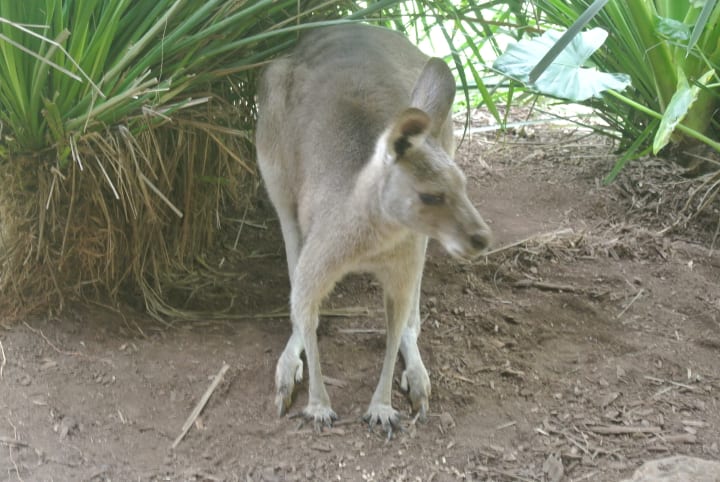
5. The number 5 danger in Australia is the Bush Fire. More than simply annoying, a bush fire fueled by plus 100⁰F temperatures, hot dry winds and oily and exploding eucalyptus trees can indeed become catastrophic in a very short period of time. Over 18 million hectares of land area burned in the Australian bushfire season 2019–2020. These fires destroyed nearly 6000 buildings including almost 3000 homes. In addition to human fatalities, many millions of animals were also killed. In 1994 a huge fire threatened and consumed part of Manly, a suburb of Sydney. A decade earlier, the fire that ravaged large portions of Victoria, was marked as the biggest natural disaster of Australia’s history, although the Cyclone Tracy survivors in Darwin might argue with that.
4. Since Australia is famous for its beaches and swimming and surfing, I will list the next most dangerous phenomena as a group. I will entitle the group – The Killers of the Sea. Out of all the species of deadly sea creatures out there, Australia is home to three quarters of them. Number one on this sub-list will, of course, be the Blue Box Jellyfish. The Blue Box is a jellyfish which has a sting comparable, according to most surviving victims, to a burning cigarette stuck to your arm or leg or face or groin or . . . and that’s if just one stinger is applied. If a whole tentacle of stingers happens to hit the mark then the sting is comparable to, say, a carton of burning cigarettes stuck to your . . . well, you get the point. I will also list the Blue Bottle Jellyfish in this group even though it is really not dangerous (life and death-wise anyway). It truly is just annoying. Other venomous sea creatures such as the Blue Ring Octopus, possibly the most toxic of all sea creatures on the planet and which has a bite for which there is no known anti-venom and the Stone Fish are very venomous and will kill you if you are already in a weakened state, like, say if one arm has been recently removed by a Great White Shark. The Great White, by the way, is also grouped as a Killer of the Sea – although GW sharks don’t usually go after humans – they just like to “test bite” them. Yeh right! I definitely think the danger scale has to be shifted left for this little bit of information. “Test bite my ass!” – whoa, wait a minute, what am I saying!?
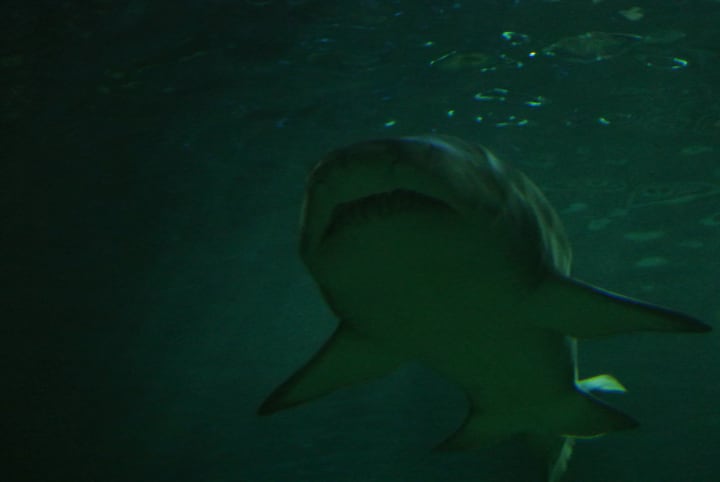
3. The next Australian danger is another group which, for the sake of convenience, includes two kinds of spiders – the Red Back Spider and the Funnel Web Spider. Neither one will kill you (usually) but they will definitely impair your pleasant memories of the trip to OZ. (By the way, did I mention that my wife conducted a spider sweep of bed, clothing and shoes every evening and every morning to make sure there were none waiting to pierce our soft, white non-Australian skin with their monster-like fangs – thanks to her, I always felt safe in Australia!!)
2. Another group occupies the number 2 dangerous phenomena of Australia. One of them will kill you by slicing your carotid artery with its bladed ankles – the Cassowary. The other will just clamp you around the waist with its big jaws and then take you under water for a “death roll” until you drown and it can gobble you up (or down) – the Saltwater Crocodile. Luckily the Cassowary is shy and doesn’t like to come anywhere near humans and the crocodile only needs to eat every month or two – so if you are lucky, your vacation may be at a time which doesn’t coincide with a Cassowary sighting or with a crocodile lunch break. Anyway, both of these animals are dinosaurs – unchanged in time over millions and millions of years. They are obviously survivors with no recollection of empathy toward a more recently evolved species like Homo sapiens sapiens. That alone scares the hell out of me enough to lump them together into second place.

1. Well, here is the one all of you have been waiting for – the number one clear and present danger in Australia. Again, I forward this position as a group of animals rather than an individual entity. Really, they could have finished second or third but since we first visited Australia in the Year of the Snake (on the Chinese Calendar), I figured that they deserve to get top spot. Snakes. Yes snakes. Australia possesses most of the deadliest snake species in the world. The Taipan (world’s deadliest venom) – the best you can hope for with this slithery not-so-little reptile is that if it bites you, you will have a pen and some paper with you. That, of course, would be to quickly write your will before you expire. The Common Brown Snake and the Tiger Snake are only slightly less venomous but will kill you with a single gnash if the wound is untreated and since dead is dead, I guess it doesn’t really matter which one it is that puts a couple of holes in you.

So, there’s the list. We obviously and thankfully did not encounter very many of the place holders on the list but we did see a few. But with a list like that, why would anyone want to travel to, let alone live in a place like Australia with danger lurking around every corner and inside every shoe or bathtub. Heck, there are some dangerous things that didn’t even make the list. Jumping out of an airplane (well, being pushed actually) fell in at number 97 for danger – it barely made the top 100.
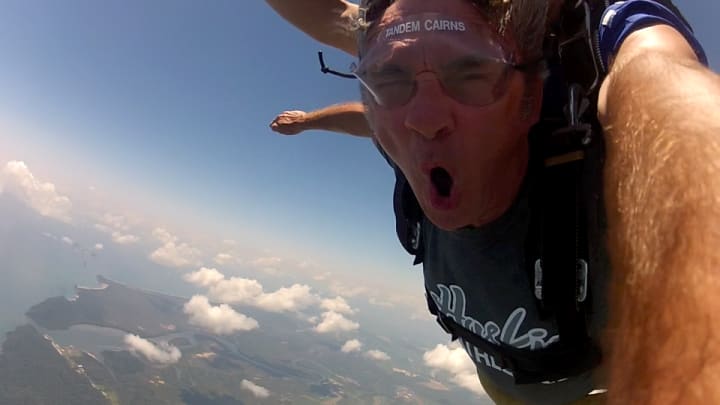
That’s the crazy thing about danger in Australia. Apparently, there are not enough animals, plants and natural phenomena to kill, maim, paralyze or debilitate a body as it is, so the locals threw in some other stuff like bungee jumping, zip-lining, skydiving, scuba diving and snorkeling just to finish off the ones immune to shark bites and the venom of poisonous snakes. Seriously though, Australia is a wonderful place and we are extremely grateful that we had the opportunity to share in the experience of visiting there, if only for a brief time and if only to scratch the surface of what that magnificent country has to offer. Next time we’ll finish it off, hopefully before it finishes us off.
About the Creator
John Oliver Smith
Baby, son, brother, child, student, collector, farmer, photographer, player, uncle, coach, husband, student, writer, teacher, father, science guy, fan, coach, grandfather, comedian, traveler, chef, story-teller, driver, regular guy!!


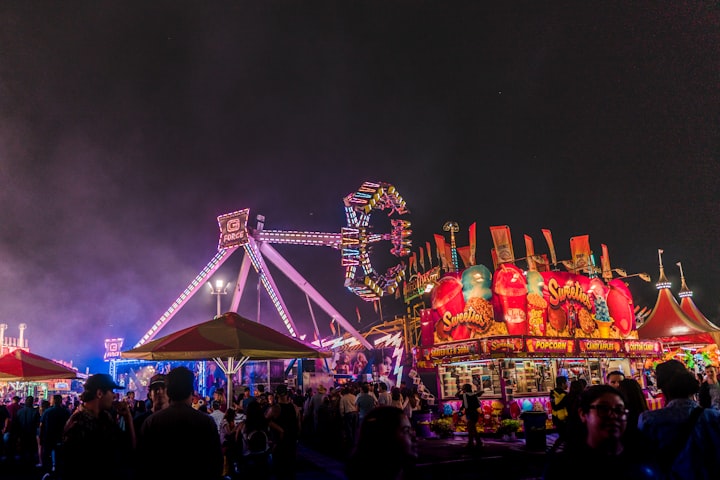



Comments (1)
Here's to the Land of OZ!!!!